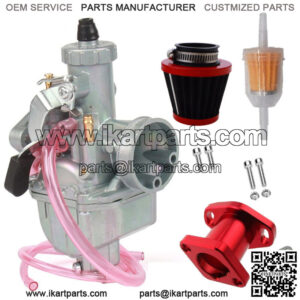1. Remove The Carburetor
The first step is to remove the carburetor from the engine. Before you do though, make sure to unscrew the carb top and throttle cable at the top of the carburetor. Make sure to hold onto the spring on the inside to prevent it from being damaged as you remove it from the carburetor and place it somewhere safely (inside the seat is always the best place).
All you need to do next is unscrew the grips that keep the carburetor fastened to the engine and air filter box, as well as any extra fuel lines attached to the carburetor. You’ll likely see the intake and outtake fuel lines, but be careful when removing these from the carburetor.
Any leftover fuel that’s in these fuel lines will be spilling out of them, so it’s a good idea to cover any exposed parts of your kart with a cloth to prevent them from being damaged by the fuel. You don’t want fuel on the outside of the engine or even on the chassis itself.
2. Open Up Your Carburetor
The next step is to open the carburetor. You’re going to be opening the bottom part of the carburetor, so it’s essentially upside down compared to when it was fixed onto the kart’s engine. The bottom of the carburetor will have either 3 or 4 screws depending on the brand of the carburetor.
Use your Allen wrench to remove these screws from the carburetor and the lid will lift right off. However, this is where you need to be careful with the carburetor, as any leftover fuel will likely spill out of the carburetor once again.
You also need to be careful not to tip the carburetor over as the floats are extremely sensitive, and you need to remember which one goes where. When removing these, carefully place them next to one another and remember which one is on the left side and which one is on the right side.
Carefully remove the float needle and pin from the carburetor. You can use your point nose pliers here but it’s not essential. Make sure that you place them somewhere safe if you’re not using a workbench, as these smaller parts can easily disappear if you’re not careful.
3. Remove The Jets
The next step is to carefully remove the jets using the flat screwdriver. Start with the main jet and work your way down to the smallest jet. Remember, there are a total of 4 jets in the Rotax carburetor, the last one can be found underneath the middle one, and you’ll need a small flat screwdriver for this.
Just like with the float pin and needle, make sure you place these jets down carefully and in order of when you took them out. This will ensure that you don’t lose them, and you can easily put your carburetor back together at the end.
If there are changes in temperature, air pressure, or even humidity, take this opportunity to check which jetting setup is needed for the day ahead. This way you can quickly swap out your jets before you get out on track.
4. Remove The Fuel Bleed Screw
The fuel bleed screw is often overlooked when it comes to cleaning the carburetor because many people don’t realize just how important it is. The fuel bleed screw can be found on the outside of the carburetor, and you sometimes need a 12mm spanner to remove it. However, many of them can be removed with a flat screwdriver as well.
The main role of the fuel bleed screw is to mix the fuel with a small amount of air. Air is sucked into this section and transitioned into the fuel channel where it is then sent to the combustion chamber. This is essentially the third most important part of the Rotax carburetor.
If you don’t clean the fuel bleed screw, you won’t have a smooth mixture of air and fuel, which could lead to either backfiring or bogging down coming out of corners even if you’re using the right jetting setup. It can be incredibly frustrating, especially if you don’t know what’s going wrong with your kart’s engine.
5. Clean The Carburetor
Now that we’ve removed all of the required parts from the carburetor, it’s time to get cleaning. Luckily you don’t need to sit there and scrub every bit of dirt off the carburetor. You’re going to use an aerosol can of brake cleaner or carb cleaner to do that for you. The high-pressure solvent will clean dirt off the carburetor quickly.
You’ll want to clean every section of the carburetor body, from the outside to the inside, and every area that you can get into. If you’re struggling, you can attach a nozzle that will help you to get into the hard-to-reach areas of the carburetor body.
Brake cleaner is the best solution as it’s stronger than carb cleaner and it will remove any old fuel lying around, but either one will work. Once you’re done, you can use a high-pressure air hose to dry the carburetor, or you can leave it to air dry.
6. Clean The Carburetor Parts
Next, we have to clean all the internals of the carburetor. Everything that you have removed from the carburetor will need to be cleaned, and the best way to do this is by using your point nose pliers to pick each item up and spray it down with brake cleaner or carb cleaner.
Make sure to be careful when handling all of these as they can easily get lost if you’re not paying attention. Once again, you can air dry them, or use the high-pressure air hose to dry each item quickly.
As a reminder, here are all the items you should have from the carburetor:
- Float bowls
- Float pin
- Float needle
- 4 jets
- Fuel bleeding screw
7. Reassemble The Carburetor
Once all of the items in the carburetor have been cleaned and dried, it’s time to put it all back together again. It might seem like a difficult task at first when you’re looking at all of the parts you’ve just taken off your carburetor, but all you need to do is reverse the steps above and put the entire carburetor back together.
Starting with the fuel bleeding screw, you can tighten it to the outside of the carburetor
(but not too tight – the general rule is 4 half turns once the screw catches). Then install your jets back in the order that you took them out.
From there you simply need to reinstall the float needle and pin. When replacing the floats make sure they are resting carefully in the correct position while you put the lid back on the carburetor. Use the Allen wrench to secure the carburetor lid in place.
8. Secure The Carburetor To The Engine
The final step is to put the carburetor back onto the engine and then you’re all set to go. Turn the carburetor on the right side up again and secure the clamps (both going to the air filter box and the engine).
Carefully replace the throttle cable and carb top and secure it tightly. Make sure to reconnect all of the fuel lines and valves. While doing so be sure to check each fuel line for any damage or general wear, as these may need to be replaced after some time.
Before you jump into your kart, make sure to start the engine and let the fuel run through the carburetor for a minute or 2. You could even push the throttle down once or twice to make sure that your cable is still working properly and the carburetor is not blocked or reassembled incorrectly.

